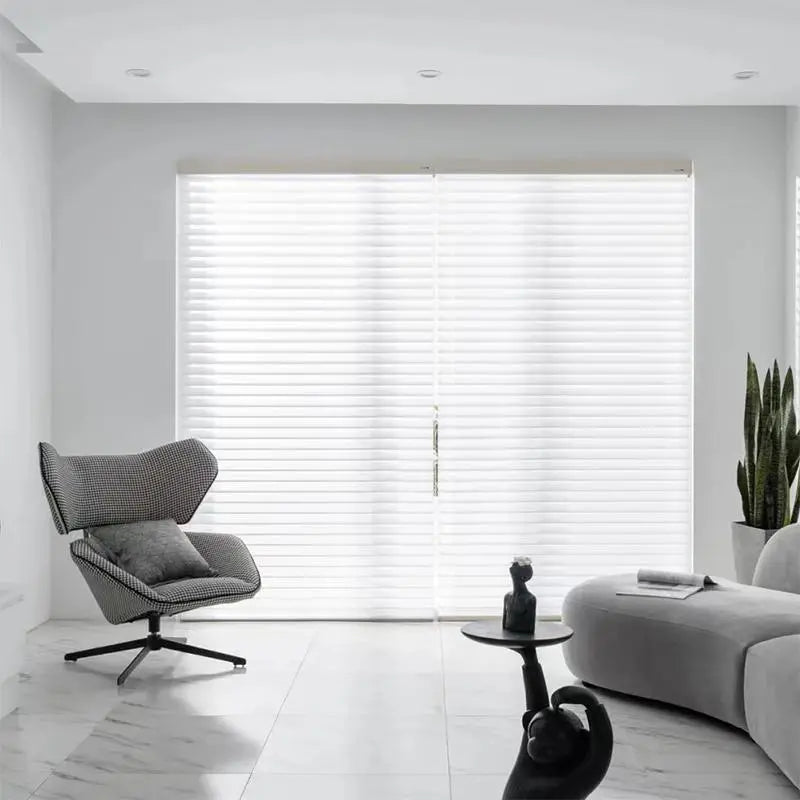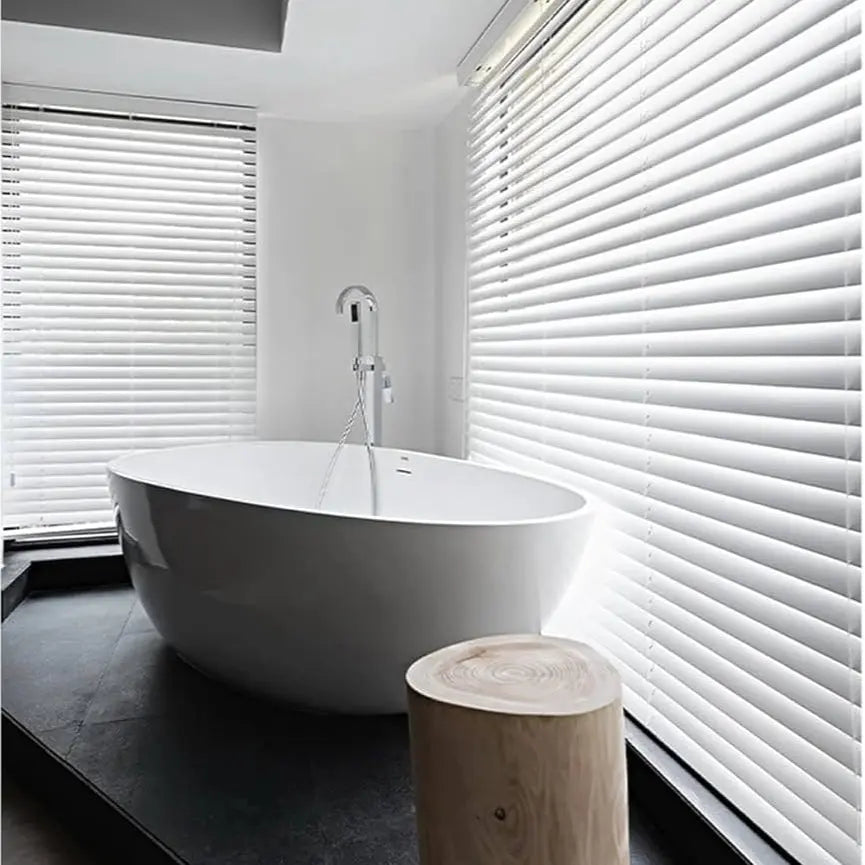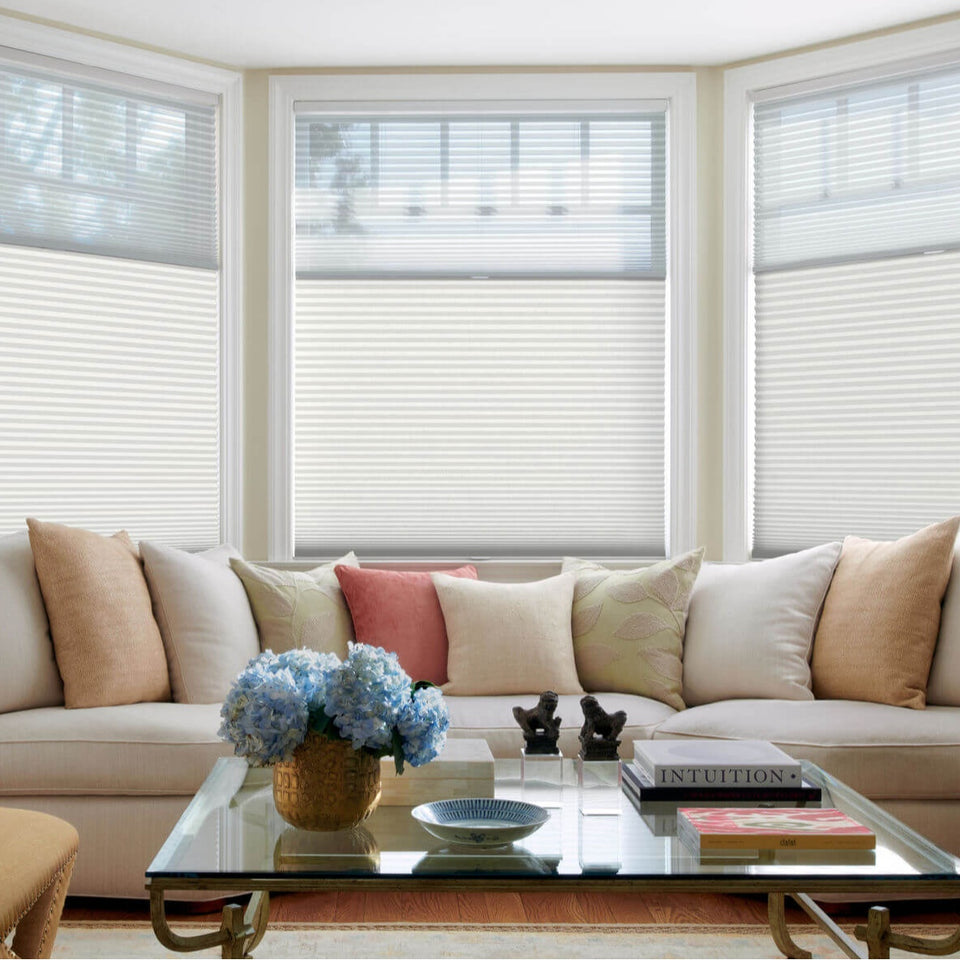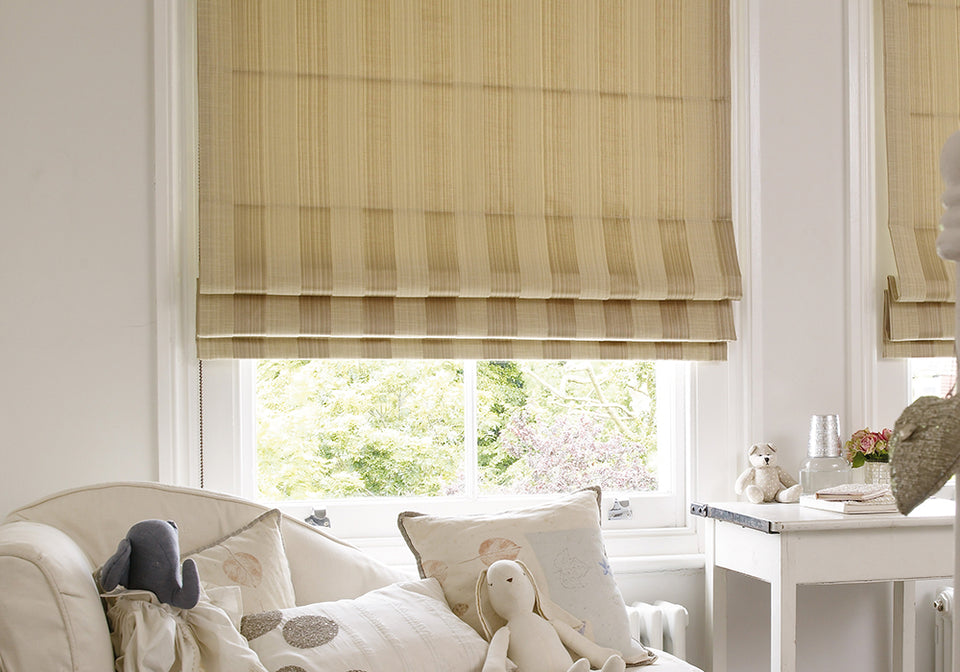What Are Curtain Headers?
A curtain header is the style of finish at the top of a curtain panel, where it attaches to a curtain rod or track. This detail influences how the fabric drapes, how the curtain moves, and the overall ambiance it creates.
Why It Matters:
- Influences fullness and drape
- Affects light control and stack-back space
- Sets the tone for your room’s aesthetic
Popular Curtain Header Styles and How They Work
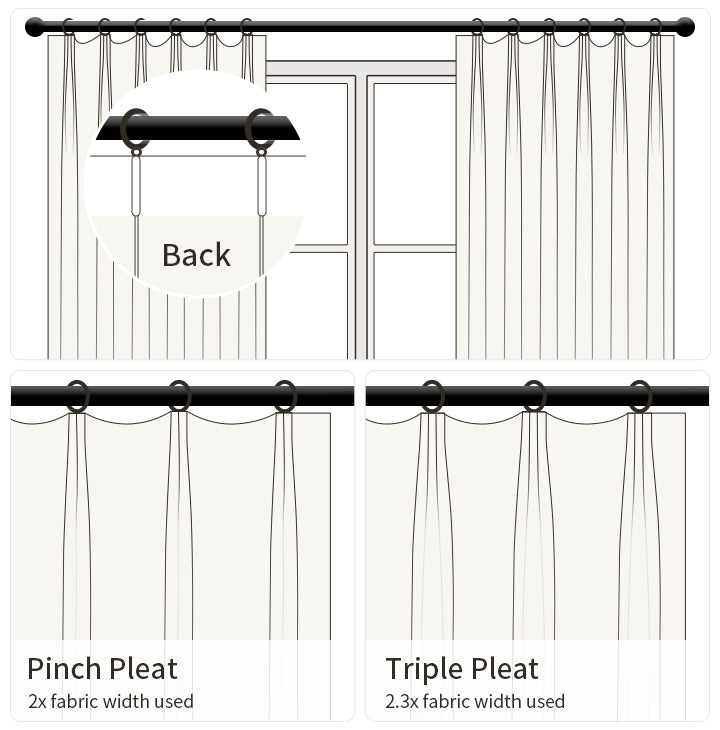
Pinch Pleat (Double & Triple)
Best For: Traditional, elegant interiors
Double Pinch Pleat uses 2 folds per pleat and generally requires 200% fullness.
Triple Pinch Pleat adds a third fold, using 230% fullness for a richer, more luxurious look.
Hanging Options: Compatible with traverse rods, channels, and rings.
Functionality: Structured drape and excellent for formal spaces.
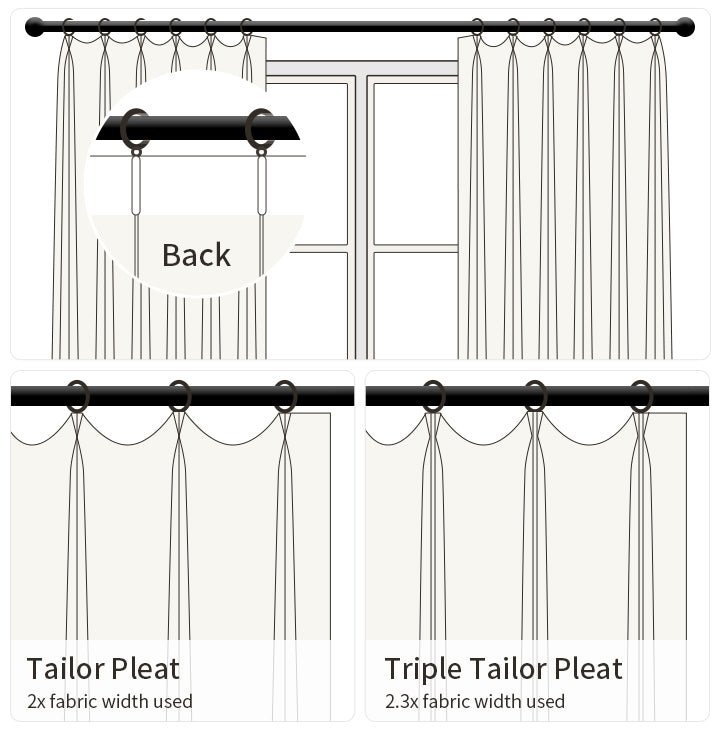
Tailor Pleat (Double & Triple)
Best For: High-end homes and formal settings
Tailor pleats open wider at the base than pinch pleats, offering a softer silhouette.
Fabric usage: 200–230% depending on pleat count.
Offers larger spacing between pleats (5.5–6.5 inches).

Goblet Pleat
Best For: Traditional and luxurious decor
Defined by a “goblet” shape at the top of each pleat.
Works best with heavy, voluminous fabrics.
Requires 200% fabric width for optimal fullness.

Inverted Box Pleat
Best For: Contemporary or transitional interiors
Pleats are hidden at the back, creating a flat, tailored front.
Clean lines with modern appeal.
Requires 200% fullness and works with both tracks and rods.
Soft Top Header Styles (Informal or Casual Look)
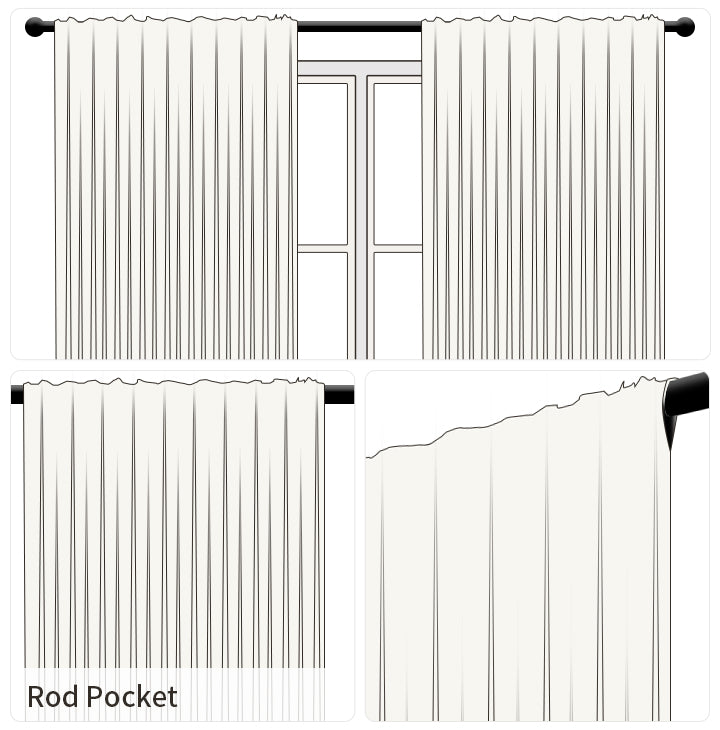
Rod Pocket
Best For: Sheers and decorative panels
Curtain rod slides through a sewn-in pocket.
Simple and neat with no visible hardware.
Not ideal for frequent operation due to drag resistance.
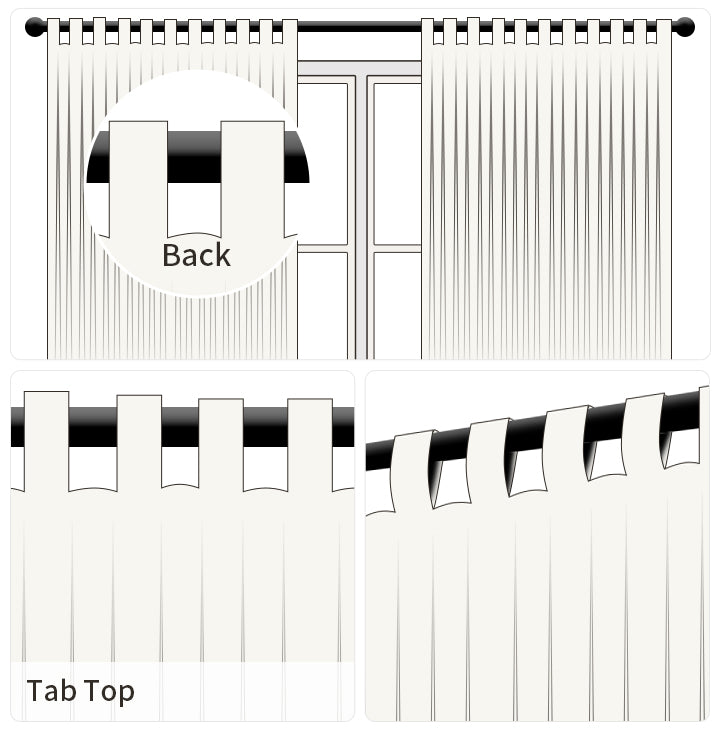
Tab Top
Best For: Casual, bohemian, or rustic interiors
Features fabric loops that pass through the rod.
Usually fixed-position and suited for lightweight fabrics.
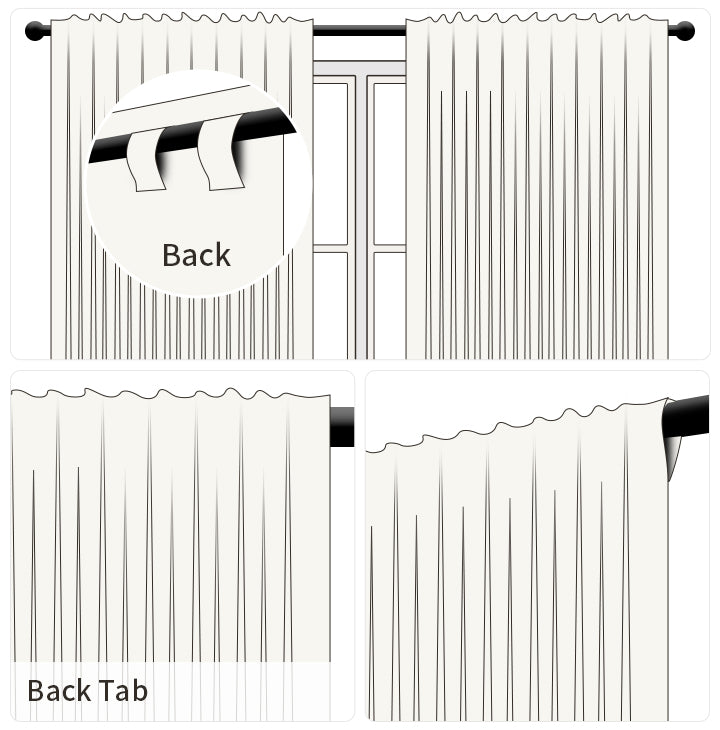
Back Tab
Best For: Clean, modern finish with hidden hardware
Tabs are stitched behind the panel, creating a tailored look.
Suitable for medium to heavy fabrics.
Multi-Functional Header Styles
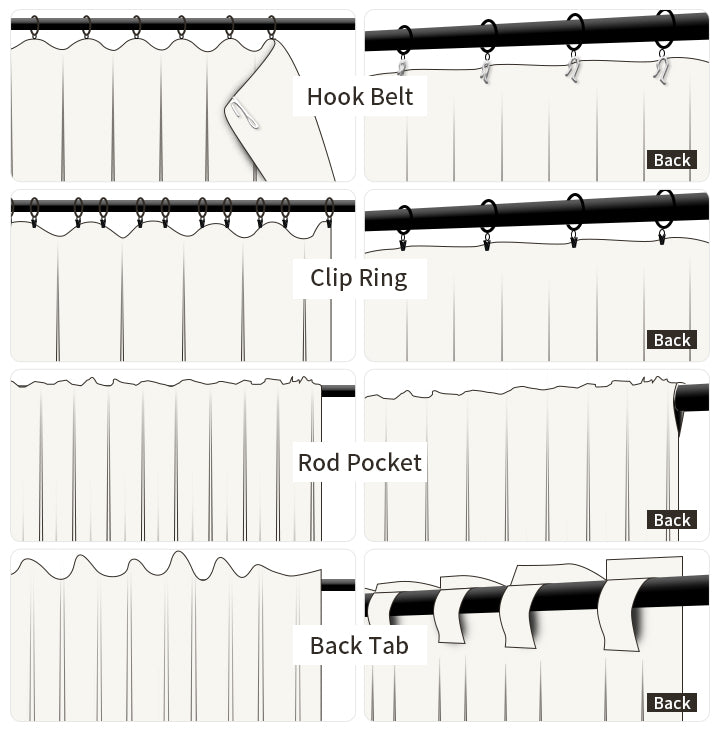
4-in-1 Header (Versatile Construction)
Best For: Flexible decor and rental properties
Allows four hanging methods: rod pocket, back tab, clip ring, or metal pin hooks.
Accommodates different rod types.
Great for spaces that change often.
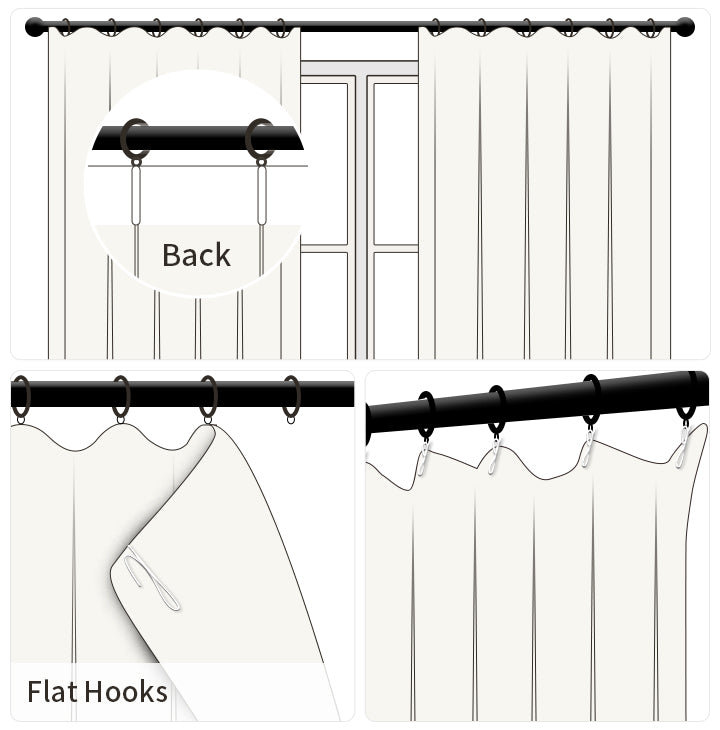
Flat Hook / Flat Panel
Best For: Minimalist or Scandinavian interiors
Clean, uninterrupted fabric face.
Adjustable pin hooks make installation easy.
Minimal fullness, suitable for decorative panels or sheers.
Modern Architectural Solutions
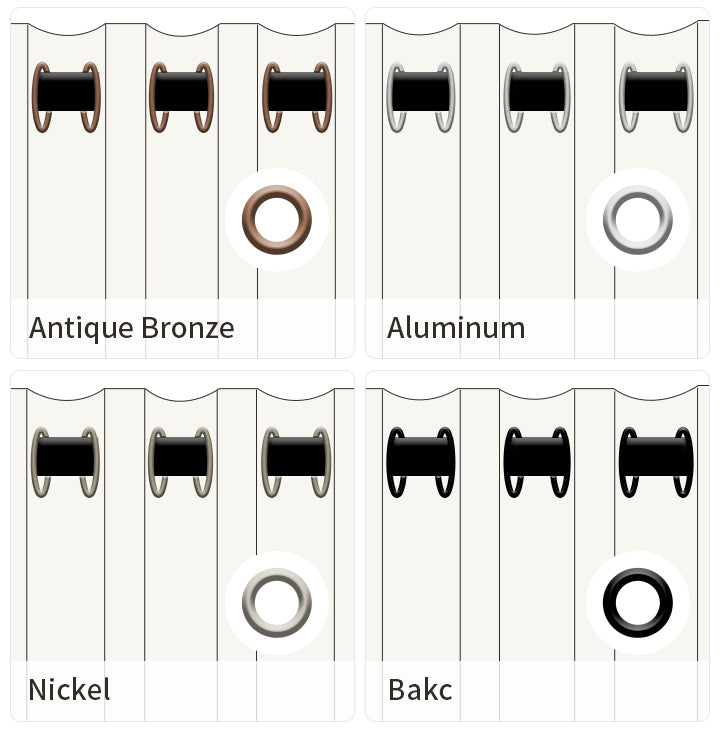
Grommet/Eyelet
Best For: Urban and modern aesthetics
Large metal rings slide directly over rods.
Clean, symmetrical wave folds.
Not ideal for blackout or full light control due to light gaps at the top.
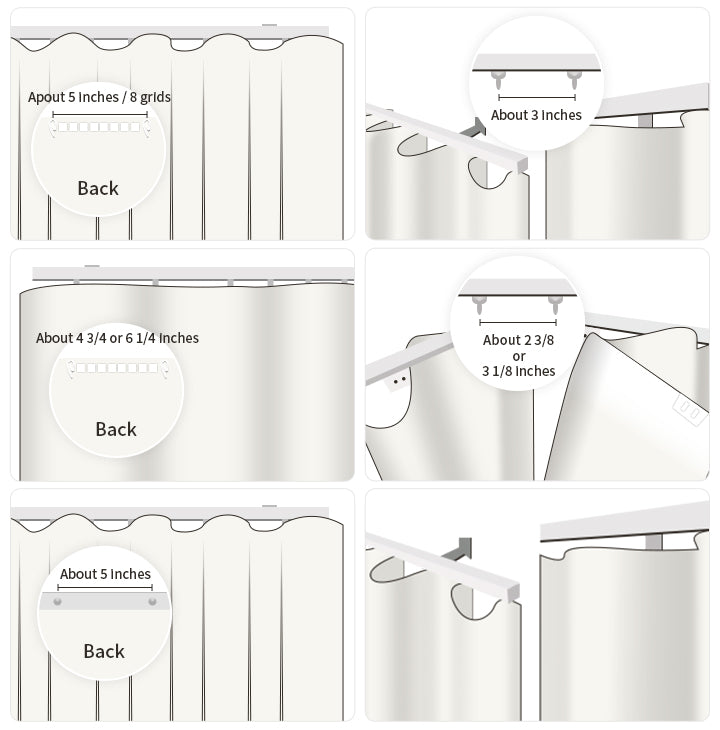
Ripple Fold (Track System Required)
Best For: Sleek, high-end spaces
Consistent wave folds offer architectural flow.
Requires specialized carriers and tracks.
Excellent for floor-to-ceiling applications and commercial settings.
Key Factors in Choosing a Curtain Header
1. Design Style
- Classic (Pinch, French, Tailor)
- Modern (Ripple, Grommet, Flat)
- Casual (Tab, Rod Pocket)
2. Fabric Weight
- Heavy fabrics: Pinch, Tailor, Goblet
- Light fabrics: Tab, Rod Pocket, Ripple
3. Functionality
- Frequent use: Pinch, Ripple, Back Tab
- Decorative: Tab Top, Rod Pocket
4. Light Control & Privacy
- Best coverage: Pinch Pleat, French Pleat, Pencil Pleat
- Moderate coverage: Grommet, Tab Top
- Layer with sheers or blackout linings for flexibility
Quick Reference: Fullness & Panel Width Calculation
| Heading Style | Fabric Fullness | Best Use Case |
|---|---|---|
| Pinch Pleat | 2x to 2.3x | Ideal for formal rooms and full coverage |
| Goblet | 2x | Suited for classic, high-ceilinged spaces |
| Tailor Pleat | 2x to 2.3x | Perfect for elegant drapes and luxury interiors |
| Flat Panel | 1.5x–2x | Best for modern, minimalist setups |
| Grommet | 1.5x–2.5x | Excellent for easy sliding and casual use |
| Ripple Fold | 2.1x–2.3x | Provides consistent folds and a premium look |
| Rod Pocket / Tab | 1.5x–2x | Great for light fabrics and fixed positions |
Pleat Spacing and Numbers for Different Widths
The width and spacing of pleats may slightly vary depending on the length of your curtain track or rod. Generally, pleats are spaced about 5.5 inches apart. If you have specific spacing requirements, please contact us for custom orders, which may incur additional fees.
Pleat Pin Hook Guidelines:
- 50 inches width: 10 pleats
- 72 inches width: 14 pleats
- 84 inches width: 16 pleats
- 100 inches width: 19 pleats
- 110 inches width: 21 pleats
- 120 inches width: 23 pleats
- 150 inches width: 29 pleats
| Rod Length (inch) | Per Panel Width (inch) | Fabric Usage (inch) | Numbers of rod rings & pleats | Pleats space apart distance (inch) | Stacked width (inch) |
|---|---|---|---|---|---|
| 26 | 15 | 34 | 4 | 4 3/4 | 3 |
| 34 | 19 | 42 | 5 | 5 | 3 7/8 |
| 40 | 22 | 48 | 5 | 5 1/2 | 4 3/8 |
| 46 | 25 | 54 | 6 | 5 | 5 |
| 52 | 28 | 60 | 6 | 4 3/4 | 5 5/8 |
| 60 | 32 | 68 | 7 | 5 3/8 | 6 3/8 |
| 72 | 38 | 80 | 9 | 4 7/8 | 7 5/8 |
| 80 | 42 | 80 | 9 | 5 3/8 | 8 3/8 |
| 88 | 46 | 87 | 10 | 5 1/8 | 9 |
| 96 | 50 | 94 | 10 | 5 5/8 | 10 |
| 100 | 52 | 98 | 10 | 5 7/8 | 10 3/8 |
| 116 | 60 | 112 | 12 | 5 1/2 | 12 |
| 128 | 66 | 123 | 13 | 5 3/8 | 13 14 |
| 136 | 70 | 130 | 14 | 5 1/2 | 14 |
| 140 | 72 | 134 | 15 | 5 1/2 | 15 1/4 |
| 148 | 76 | 141 | 15 | 5 3/8 | 16 |
| 156 | 80 | 148 | 16 | 5 1/4 | 16 7/8 |
| 164 | 84 | 155 | 17 | 5 5/8 | 18 |
| 176 | 90 | 166 | 19 | 5 5/8 | 19 1/4 |
| 188 | 96 | 177 | 19 | 5 3/8 | 19 5/8 |
| 192 | 98 | 180 | 19 | 5 5/8 | 20 |
| 196 | 100 | 184 | 19 | 5 1/2 | 22 |
| 216 | 110 | 202 | 21 | 5 1/2 | 24 |
| 236 | 120 | 220 | 23 | 5 1/2 | 24 |
For pinch pleat, tailor pleat, inverted pleat, and goblet style (Dimension in inches)
| Finish Width | Fullness | Side Hem | Pleats Numbers | Pleat Depth | Side Tuck | Pleats Space |
|---|---|---|---|---|---|---|
| 25 | 2 | 1 | 6 | 1 1/4" | 2" | 5" |
| 30 | 2 | 1 | 7 | 1 1/4" | 2" | 5" |
| 40 | 2 | 1 | 8 | 1 1/4" | 2" | 5 3/4" |
| 50 | 2 | 1 | 10 | 1 1/4" | 2" | 5 5/8" |
| 60 | 2 | 1 | 12 | 1 1/4" | 2" | 5 1/2" |
| 70 | 2 | 1 | 14 | 1 1/4" | 2" | 5 3/8" |
| 80 | 2 | 1 | 16 | 1 1/4" | 2" | 5 3/4" |
| 90 | 2 | 1 | 17 | 1 1/4" | 2" | 5 5/8" |
| 100 | 2 | 1 | 19 | 1 1/4" | 2" | 5 5/8" |
| 110 | 2 | 1 | 21 | 1 1/4" | 2" | 5 3/4" |
| 120 | 2 | 1 | 23 | 1 1/4" | 2" | 5 1/2" |
For triple pleat and triple tailor pleat style (Dimension in inches)
| Finish Width | Fullness | Side Hem | Pleats Numbers | Pleat Depth | Side Tuck | Pleats Space |
|---|---|---|---|---|---|---|
| 25 | 2.3 | 1 | 6 | 1 1/4" | 2" | 5" |
| 30 | 2.3 | 1 | 7 | 1 1/4" | 2" | 5" |
| 40 | 2.3 | 1 | 8 | 1 1/4" | 2" | 5 3/4" |
| 50 | 2.3 | 1 | 10 | 1 1/4" | 2" | 5 5/8" |
| 60 | 2.3 | 1 | 12 | 1 1/4" | 2" | 5 1/2" |
| 70 | 2.3 | 1 | 14 | 1 1/4" | 2" | 5 3/8" |
| 80 | 2.3 | 1 | 16 | 1 1/4" | 2" | 5 3/4" |
| 90 | 2.3 | 1 | 17 | 1 1/4" | 2" | 5 5/8" |
| 100 | 2.3 | 1 | 19 | 1 1/4" | 2" | 5 5/8" |
| 110 | 2.3 | 1 | 20 | 1 1/4" | 2" | 5 3/4" |
| 120 | 2.3 | 1 | 22 | 1 1/4" | 2" | 5 3/4" |
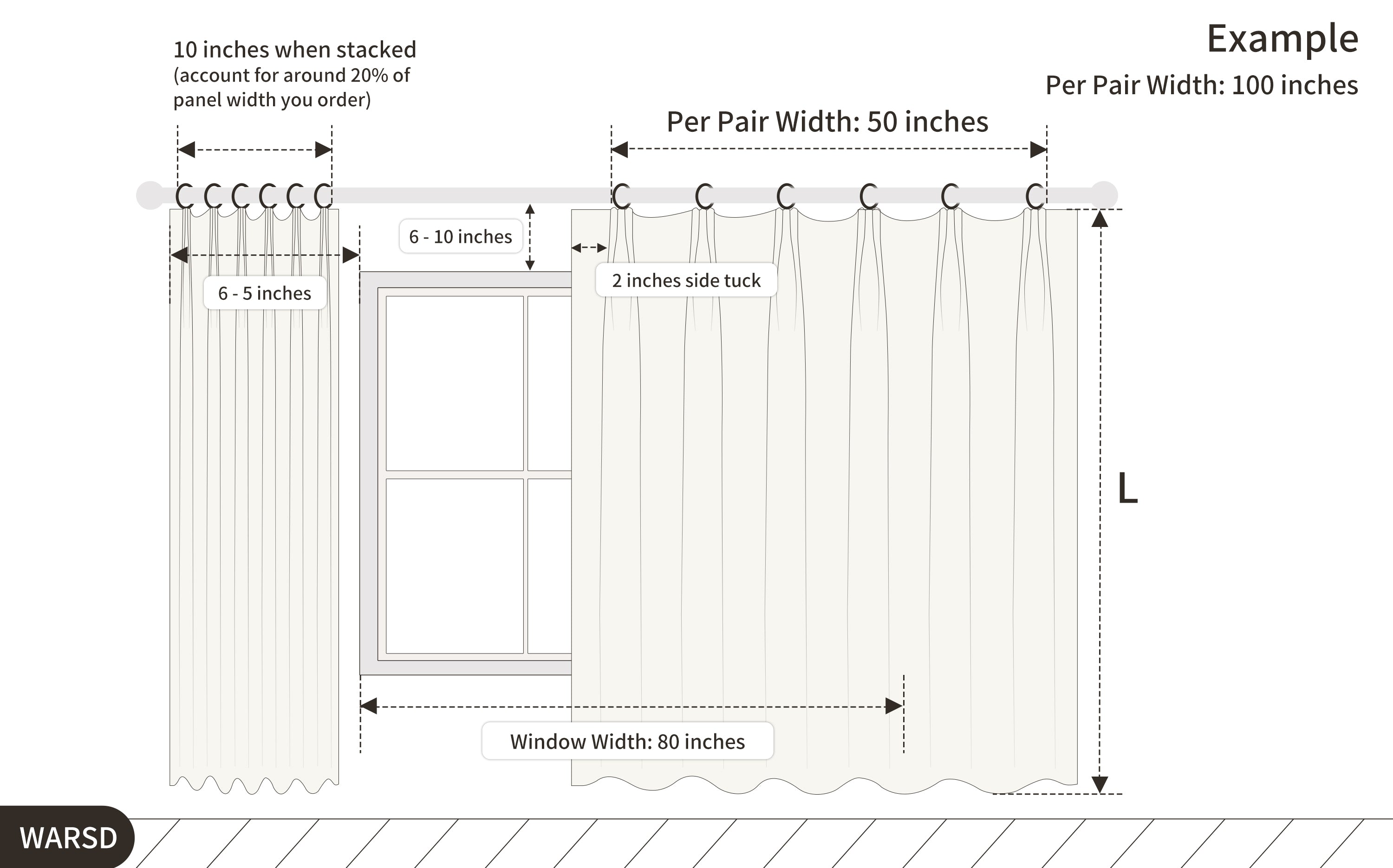
How to Order the Correct Curtain Width & Length
- Panel Width: The width of the panel is already set by the pleats. For optimal pleating, the fabric width should be between 200% and 230% of the desired finished width.
- Length: Measure from the eyelet ring (where curtain hooks are attached) down to the floor. For a rod or track length of 100 inches, consider possible overlap and privacy gaps, and then order either 1 panel at 100 inches width or 2 panels at 50 inches each.

Understanding Stacked Width
- If you want your window to be fully visible when the curtains are open, you must account for the stacked width. Typically, the stacked width accounts for about 20% of the total curtain width. This will help determine the appropriate rod length to ensure smooth operation and aesthetic balance.

The Adjustable Pin Hook
The adjustable pin hooks feature a ratchet system that allows for height adjustment of up to 3 inches. The hooks are included with your curtains, though drapery rod rings are sold separately.
- Pin Hook Height: 3.5 inches
- Pleat Depth: 1 inch
- White Back Tape Width: 3 1/8 inches
- Side Hem: 1 inch
- Bottom Hem: 3 1/8 inches
Matching Header Style with Rod & Track
When hanging pleated curtains, the hooks can be adjusted vertically by approximately 3 inches. Track height is usually about 1 3/4 inches. We recommend adjusting the hooks to cover the track for a seamless appearance.
Important Tip:
If the curtain header covers the track, it may cause the fabric to turn outward, potentially affecting both the curtain’s appearance and its smooth operation. For optimal performance and aesthetics, we recommend hanging the curtains slightly below the track for better flow and function.
Header Style Match Rod Track
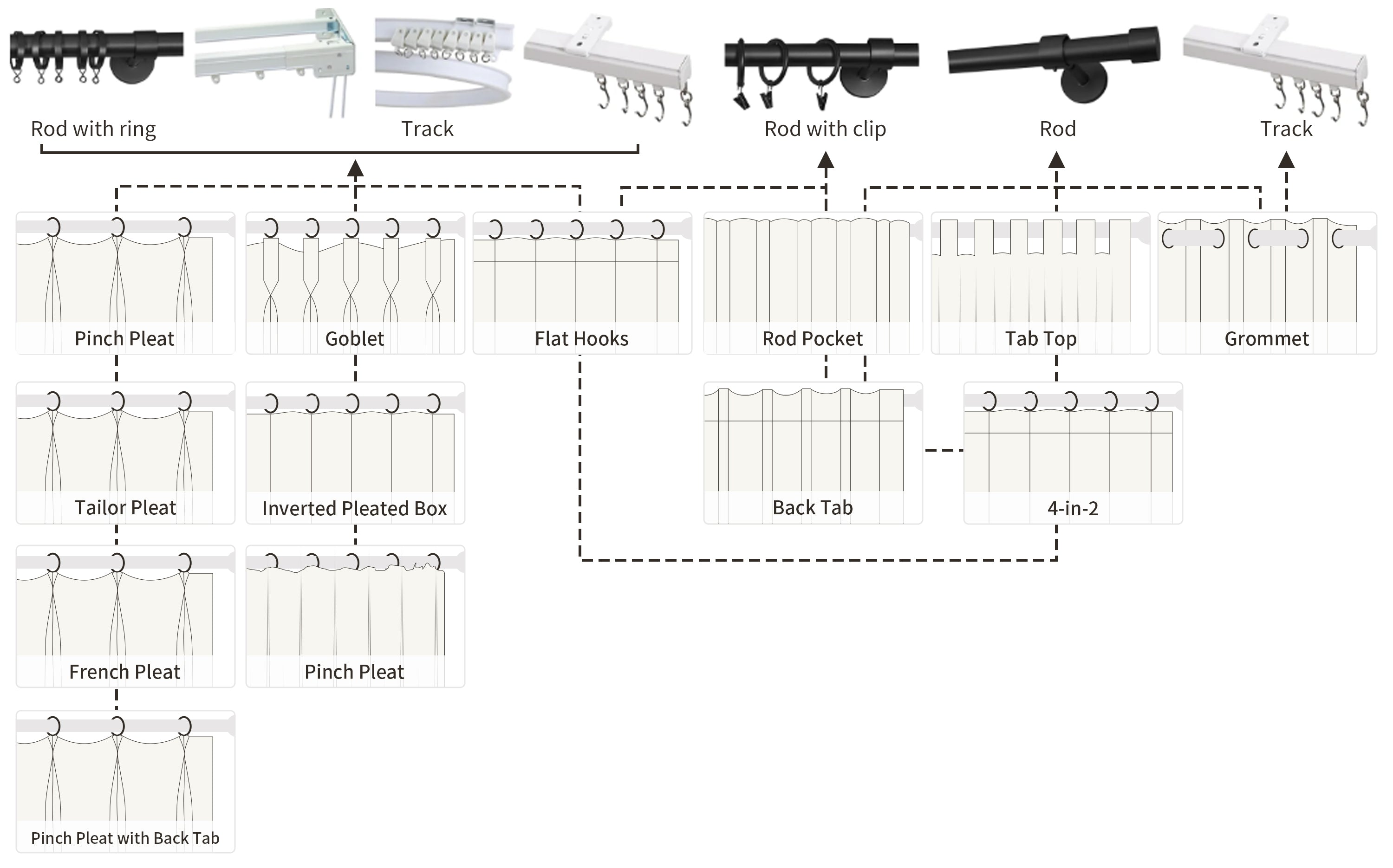
The pleated curtains come with hooks that can be adjusted up and down by about 3 inches. The Track height is about 1 3/4 inches. We can cover the track by adjusting the hook.
When the curtain header covers the track, it may cause the fabric to turn outward slightly, which can compromise both the appearance and the smooth operation of the curtains.
For optimal performance and aesthetics, we do not recommend installing the curtains in this manner.
Maintenance and Durability
- Easiest to maintain: Rod Pocket, Tab Top, Grommet (machine-washable fabrics)
- Requires more care: Pleated headers (may need dry cleaning or delicate handling)
- Long-Term Use: Pleated curtains are durable and adaptable to new spaces
Note:
Choosing the right curtain heading is a balance of form and function. Whether you prefer the sharp structure of pinch pleats or the soft wave of ripple folds, your header style should reflect your personal style, functional needs, and interior goals. From enhancing light control to defining the room’s tone, the right header can transform an ordinary window into a statement feature.
Need help choosing or customizing your curtain headers? Contact us for personalized recommendations based on your measurements, fabric choice, and design vision.





